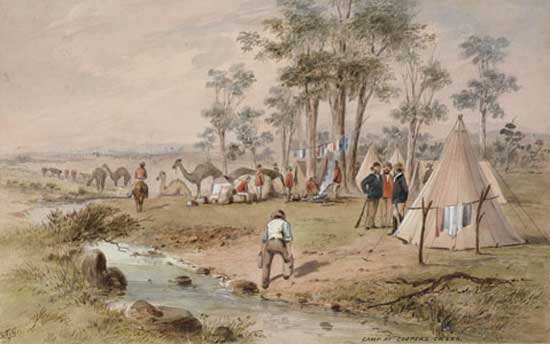Burke and Wills
Robert O'Hara Burke and William John Wills share the honour of being the first Australian explorers to cross the continent from south to north - though they paid the ultimate price for their triumph. Their expedition was one of the largest, best equipped and most elaborate in 19th century Australia. However, both men failed to return to Melbourne, perishing from exhaustion and starvation at Cooper's Creek in North Queensland.
The Burke and Wills expedition: crossing the continent
By the 1850s, the focus of exploration had shifted to Central Australia and in particular to crossing the continent from south to north.
The race was on between Victoria and South Australia to see which state could be the first to scout a location for a telegraph station on the north coast and find a course for the telegraph line to connect with the southern cities.
In 1860, a South Australian, John McDouall Stuart, became the first European to gaze upon the 'red centre'. However, a combination of scurvy, lack of water and hostile Aborigines forced him to turn back before he could reach the north coast.
In the same year Robert O'Hara Burke and William John Wills set out from Melbourne to travel to the Gulf of Carpentaria, Qld, via the Darling River and Cooper's Creek. Funded entirely by the newly independent colony of Victoria, partly by subscription, there was much public interest in their expedition.
The party consisted of 15 men and they were provided with camels, horses, wagons and enough food for two years. They left Melbourne on 20 August, 1860. After a slow passage they reached Menindee, NSW, on the Darling River at the beginning of October. Here, in a controversial move, Burke left most of his men and equipment and set out with six men and 15 camels for Cooper's Creek, Qld.
Camp at Coopers Creek, c.1862, by S.T. Gill
Watercolour DGA 15/ 3
At the Cooper's Creek depot, stores were left under the charge of William Brahe. Burke plunged on with three men, Wills, John King and Charles Gray in a dash for the Gulf of Carpentaria. They reached the Gulf, half starving, in February, 1861. During the return journey Gray died. When the three remaining men staggered into the depot at Cooper's Creek they found it deserted - the ashes of the campfires still warm. Brahe's party had left only seven hours earlier with most of the food.
Arrival at Carpentaria, c.1862, by S.T. Gill
Watercolour DGA 15/ 6
Instead of following them, Burke decided to make for the police station at Mount Hopeless, 150 miles away. Before leaving he buried a letter explaining his decision. The three men were too weak to make much progress and they stayed close to Cooper's Creek hoping to be rescued. Wills died first followed by Burke two days later. King managed to survive with the help of the local Aboriginal people and was eventually found by a rescue party led by A.W. Howitt.
A Royal Commission was held to enquire into the deaths of Burke and Wills. It found that Burke had made a number of wrong decisions. Burke's journey had little value in terms of exploration as he failed to keep a detailed journal and made no scientific observations. His route through tropical Queensland was only practical in the exceptionally dry season he had experienced.
The artist William Strutt (1825-1915) took a keen interest in the Victorian Exploring Expedition. He watched the preparations and departure of the explorers and even followed them to their first camp at Essendon, where he had some photographs taken. These are the only known photographs of the expedition. Strutt's Burke and Wills albums also contain his own detailed drawings and notes which he used as source material for his later artworks.







